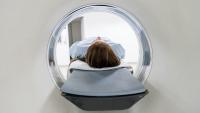About PET Scans

What Is a PET Scan?
A positron emission tomography (PET) scan uses very small amounts of radioactive material that is injected into a vein to create a picture of the brain. The injected material binds to the protein we want to look at. It is tagged with a small amount of radiation that our very sensitive PET camera can detect. For each PET scan, you will have an IV placed and a small amount of the radiotracer injected. After about an hour, you will lie on a bed in the PET scanner. A computed tomography (CT) scan will be taken of your head. Then we will take pictures of your brain for 20-30 minutes. You will be asked to lay still during the scan.
How Much Radiation Will I Be Exposed To and What Does That Mean?
The radiation exposure is necessary to obtain the image of the brain. This is because PET scans by nature use a small amount of radioactive dye. At these low levels, scientists are uncertain as to the actual risk and there may be no risk at all. For reference, the radiation exposure from one scan is equal to a little less than two years of living in New York, where you are exposed to background radiation. Other things we use every day expose us to radiation, such as microwaves, airplanes, and cars. Here, we are injecting the absolute minimum amount we can to keep it safe for you while still getting a good picture of the brain.
What Are the Risks Involved in a Lumbar Puncture?
You may experience a brief pain or tingling sensation in your legs during the procedure if the needle brushes against a nerve. If this happens, the needle will be adjusted. Following a lumbar puncture, some people have a mild backache at the site of needle insertion. About one-third of people have a headache for a few days after a lumbar puncture. Usually, the headache is not severe and improves without treatment other than a mild pain reliever. Headaches lasting longer than seven days develop with one in 50 to 200 lumbar punctures and usually improve gradually over two weeks. In rare cases, headaches have persisted longer. Prolonged headaches may be due to persistent leakage of spinal fluid from the area of the lumbar puncture. If the headache is prolonged, you may be referred to anesthesiology to perform a blood patch. A blood patch is a procedure in which the doctor draws a small amount of blood from your vein and injects it in the same place where the lumbar puncture was done. This way your blood blocks the leakage of the spinal fluid and eliminates the headache. There is also a very small risk of infection, however every precaution will be taken to minimize that risk using sterile surgical procedures.
Where Do the Visits Take Place?
All visits will be conducted in person at Columbia University Irving Medical Center.
How Long Will My Participation Last?
Depending on which study you are enrolled in, your participation will last from two years to five years. This means that we will call you every year to see if you are willing to come back and repeat some procedures. However, if your situation changes or you are no longer interested in participating, you can decline to come back for the follow-up visits.
What Information Will I Get Related to My Health?
We will be able to tell you a few results from this study:
The results of your memory test, your COVID serology result, and if your amyloid scan is positive or negative. A positive scan does not necessarily mean you have or will get Alzheimer’s disease. A negative scan does not necessarily mean you do not have or will never get Alzheimer’s disease. We will also inform you of anything the doctor notices in your MRI, such as a stroke or tumor.
What Are the Benefits of Participating?
There is no direct benefit from participating in our studies. These studies are aimed at helping scientists better understand the causes of Alzheimer's disease and ultimately enable early identification and treatment of this disease.